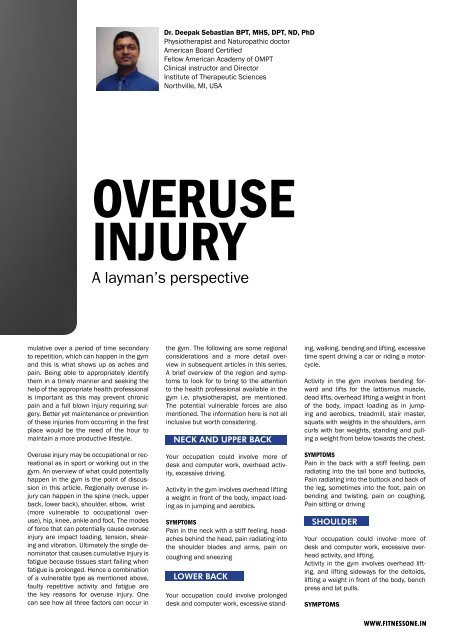2010-Vol 2 - Fitness one
2010-Vol 2 - Fitness one
2010-Vol 2 - Fitness one
Create successful ePaper yourself
Turn your PDF publications into a flip-book with our unique Google optimized e-Paper software.
mulative over a period of time secondary<br />
to repetition, which can happen in the gym<br />
and this is what shows up as aches and<br />
pain. Being able to appropriately identify<br />
them in a timely manner and seeking the<br />
help of the appropriate health professional<br />
is important as this may prevent chronic<br />
pain and a full blown injury requiring surgery.<br />
Better yet maintenance or prevention<br />
of these injuries from occurring in the first<br />
place would be the need of the hour to<br />
maintain a more productive lifestyle.<br />
Overuse injury may be occupational or recreational<br />
as in sport or working out in the<br />
gym. An overview of what could potentially<br />
happen in the gym is the point of discussion<br />
in this article. Regionally overuse injury<br />
can happen in the spine (neck, upper<br />
back, lower back), shoulder, elbow, wrist<br />
(more vulnerable to occupational overuse),<br />
hip, knee, ankle and foot. The modes<br />
of force that can potentially cause overuse<br />
injury are impact loading, tension, shearing<br />
and vibration. Ultimately the single denominator<br />
that causes cumulative injury is<br />
fatigue because tissues start failing when<br />
fatigue is prolonged. Hence a combination<br />
of a vulnerable type as menti<strong>one</strong>d above,<br />
faulty repetitive activity and fatigue are<br />
the key reasons for overuse injury. One<br />
can see how all three factors can occur in<br />
Dr. Deepak Sebastian Bpt, mhS, Dpt, nD, phD<br />
Physiotherapist and Naturopathic doctor<br />
American Board Certified<br />
Fellow American Academy of OMPT<br />
Clinical instructor and Director<br />
Institute of Therapeutic Sciences<br />
Northville, MI, USA<br />
overuSe<br />
injury<br />
A layman’s perspective<br />
the gym. The following are some regional<br />
considerations and a more detail overview<br />
in subsequent articles in this series.<br />
A brief overview of the region and symptoms<br />
to look for to bring to the attention<br />
to the health professional available in the<br />
gym i.e. physiotherapist, are menti<strong>one</strong>d.<br />
The potential vulnerable forces are also<br />
menti<strong>one</strong>d. The information here is not all<br />
inclusive but worth considering.<br />
neCk AnD UPPeR BACk<br />
Your occupation could involve more of<br />
desk and computer work, overhead activity,<br />
excessive driving.<br />
Activity in the gym involves overhead lifting<br />
a weight in front of the body, impact loading<br />
as in jumping and aerobics.<br />
SymptomS<br />
Pain in the neck with a stiff feeling, headaches<br />
behind the head, pain radiating into<br />
the shoulder blades and arms, pain on<br />
coughing and sneezing<br />
loweR BACk<br />
Your occupation could involve prolonged<br />
desk and computer work, excessive stand-<br />
ing, walking, bending and lifting, excessive<br />
time spent driving a car or riding a motorcycle.<br />
Activity in the gym involves bending forward<br />
and lifts for the lattismus muscle,<br />
dead lifts, overhead lifting a weight in front<br />
of the body, impact loading as in jumping<br />
and aerobics, treadmill, stair master,<br />
squats with weights in the shoulders, arm<br />
curls with bar weights, standing and pulling<br />
a weight from below towards the chest.<br />
SymptomS<br />
Pain in the back with a stiff feeling, pain<br />
radiating into the tail b<strong>one</strong> and buttocks,<br />
Pain radiating into the buttock and back of<br />
the leg, sometimes into the foot, pain on<br />
bending and twisting, pain on coughing,<br />
Pain sitting or driving<br />
sHoUlDeR<br />
Your occupation could involve more of<br />
desk and computer work, excessive overhead<br />
activity, and lifting.<br />
Activity in the gym involves overhead lifting,<br />
and lifting sideways for the deltoids,<br />
lifting a weight in front of the body, bench<br />
press and lat pulls.<br />
SymptomS<br />
www.fitness<strong>one</strong>.in


